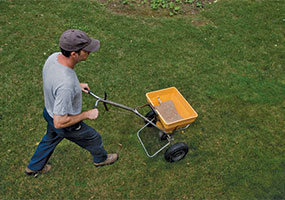Dealing with Winter Lawn Damage
Newsletters | 02.01.17
A long, cold winter can do a number on your lawn. While a thick blanket of snow can actually protect your lawn, the ice that results from repeated thawing and refreezing can be quite harmful. In addition to ice, snow mold – a fungus that thrives in cold, wet conditions – can harm or kill entire sections of turf. Even the salt that makes roads drivable in the winter can dry out and damage grass that is close to the street.

Once winter lets up, it is time to assess the damage. Start by lightly raking brown areas of your lawn. Dormant turf, with its roots intact, will stay firmly attached to the ground. Dead, dying, or diseased grass will be easily pulled up. Once troubled turf is removed, it will be clear which areas need the most attention.
Proper fertilization can help rejuvenate damaged turf. Some areas may also need full or partial reseeding depending on the extent of the damage. If you have questions regarding what can and should be done to address a damaging winter, feel free to contact us, we’ll be happy to assess your lawn care needs!

Be Careful with the Salt this Winter
Ice-melting salt can work wonders on roads, walks and driveways during the winter. However, it can also cause plant injury when it’s not applied carefully.
Salt can damage soil structure by increasing the soil’s sodium content, which leads to a decrease in the amount of nutrients, water and oxygen available to your plants. In addition, chlorine ions from salt can be absorbed by the roots and transported to plant leaves and shoots. When excessive amounts of chlorine are absorbed, you may start to notice a dried, burned effect on leaf edges (known as leaf scorch).
As an alternative to salt, you may want to consider using calcium chloride this winter (which isn’t as harmful to plants). And if you do use salt, you should try to avoid applying it near trees, plant beds, or where runoff will drain into plants when the snow melts.
